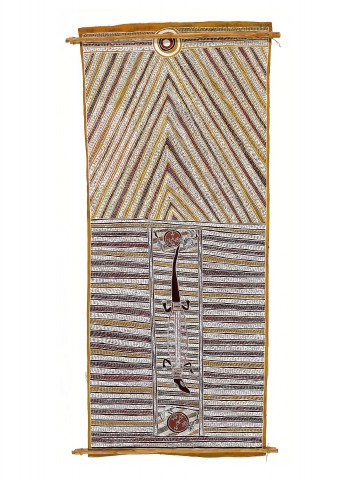WALU, 1983
DJAMBAWA MARAWILI
natural earth pigments on eucalyptus bark
207.0 x 89.0 cm
bears inscription verso: artist’s name and Buku–Larrŋgay Mulka cat. 1506J and cat. 797B FW
Buku-Larrŋgay Mulka Art Centre, Yirrkala, Northern Territory
Private collection, Melbourne
This work is accompanied by a certificate of authenticity from Buku-Larrŋgay Mulka Art Centre which states:
'Mayawuluk (c.1937) is a descendant of the warrior Wirrpanda and mother of Wakuthi's eldest son Djambawa. Djambawa has painted her Dhudi-Djapu clans design of country that was transformed by the principal creator beings for the Dhuwa moiety - the Djaŋ 'kawu.
They passed through the plains country of Yalata towards where the Dhudi-Djapu live today at Dhuruputjpi. These the Djaŋ 'kawu, two Sisters with names in this country of Ganaypa and Banyali, sang the brolga Dhan gultji as they went with their walking sticks - Wapitja. With these they dug waterholes as they went, naming, thus sanctifying them with special qualities. Today they retain these same qualities for the Yolŋu, the water and knowledge that surfaces from these wells by their actions are sung in ceremony for this country.
Waŋ'kawu the sacred goanna for Djapu clans and associate Dhuwa emerged from one of these waterholes by the upper reaches of the plain, a place called Dhakarra or Walirrwan. Waŋ'kawu witnessed the first sunrise over this area to see Daŋgultji walking over the plain, waterhole to waterhole, leaving their footprints in the drying mud.
The sacred clan design throughout this painting declares ownership of this country from Yalata to Dhuruputjpi for the Dhudi-Djapu. Through his mothers connection with these people Djambawa has the right to paint these designs with their permission. The ribbons of red white and yellow hatching refer to the freshwater that flows from the water holes of this area that is aflood during the wet. It has also been incorporated as Walu's (sun) first rays over this place.'
